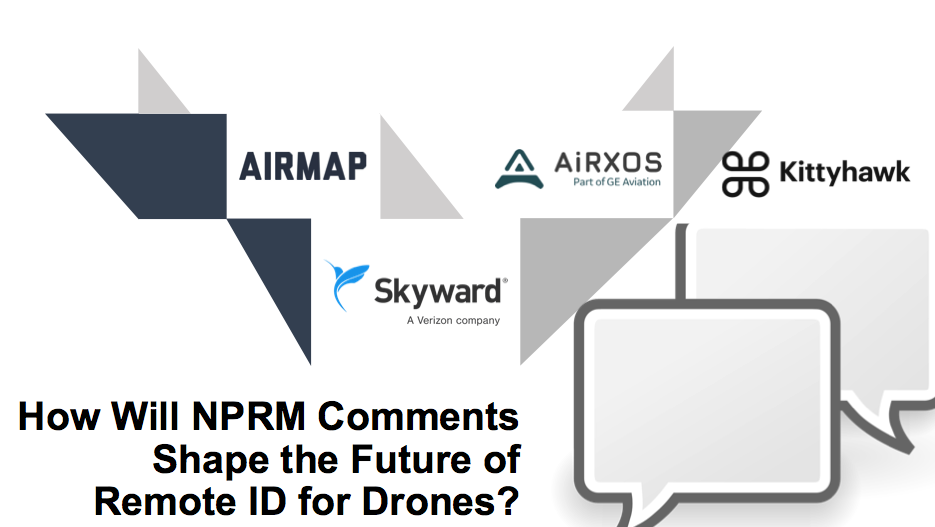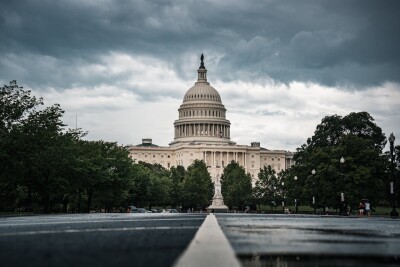Insights about how to best interpret the 53,040 comments the FAA received for their proposed rule for Remote ID, why a tiered approach to Remote ID is essential and how Remote ID can make the skies more secure were just a few of the topics that were discussed during the recent How Will NPRM Comments to the FAA Shape the Future of Remote ID for Drones? webinar. Josh Ziering from Kittyhawk, Melissa Tye, from Verizon, Jacob Ruytenbeek, from AirMap and Ted Lester from AiRXOS, part of GE Aviation, took part in a live discussion that explored all of these topics in detail, plus many others.
You can listen to the webinar yourself or read some of the articles that were written about it to get a better sense of how the participants feel the NPRM will impact the present and future of the drone industry. Their insights generated numerous questions from the live audience, some of which were addressed at the end of the webinar. We ran out of time before getting to all of them, so we gathered up those questions and reconnected with our panel (with the Skyward Team swapping in for Melissa Tye) to capture their answers.
 We removed the names of the people who asked these questions and compiled similar questions into a single one for our panel to answer in this format. One question was partially answered on the webinar itself that compelled a few more questions about that same topic. We pulled all of that together into a single question for the panel that appears as the 4th one below.
We removed the names of the people who asked these questions and compiled similar questions into a single one for our panel to answer in this format. One question was partially answered on the webinar itself that compelled a few more questions about that same topic. We pulled all of that together into a single question for the panel that appears as the 4th one below.
________________________________________________________________
The participants of this webinar are generally in favor of this approach to Remote ID, but the companies they represent stand to benefit from it in a very real way, correct? How are you able to consider what’s best for your company versus what’s best for the industry?
Jacob Ruytenbeek : AirMap supports Remote ID because it is essential to enabling advanced drone operations at scale. That benefits the industry—and society—as a whole. Remote ID will ultimately enable autonomous BVLOS operations at scale, which makes services like drone delivery and emergency response possible. These technologies serve society, not just companies who intend to provide Remote ID services.
Josh Ziering: This question is interesting because there are a lot of armchair policy makers and conspiracy theorists out there that would like to think that Remote ID stands to make USS' billions of dollars. There were similar sentiments about LAANC. The reality at Kittyhawk is that we're after one goal: enabling more flights for our enterprise customers. We want the tools to allow for more integration of drones into the NAS sooner rather than later. Our enterprise customers know that compliance is key and they want an entire platform to easily manage that all in one place. This isn't about charging for Remote ID, this is about the value we can bring as a full-stack enterprise solution to create more opportunities for flight.
Skyward Team: The FAA has made it clear that until a remote identification solution is implemented, advanced operations, such as BVLOS and package carriage, will not move forward. And unless industry can advance and scale, no companies in the UAS industry win. While we may disagree around the edges, companies generally support the rule as proposed because it represents the most efficient and practical path forward for industry. While we are advocating for rules we believe will be best for the industry, it is ultimately up to the FAA as regulatory to decide upon final rules. We will comply with whatever Remote ID construct the FAA directs.
Ted Lester: AiRXOS is in the business of helping our customers. If they are successful at using drones for advanced operations, then AiRXOS will be successful. Remote ID is a key enabler for advanced drone operations such as BVLOS and operations over people for all industry members, which is why AiRXOS supports the NPRM.
________________________________________________________________
Isn’t the big question the mode of connectivity? The FAA was clear - the I&C of UAS will happen over the Internet not on radios & radars & ADS. This is the next stage of the Internet and many model aircraft can’t connect, correct?
Ted Lester: For both Standard and Limited Remote ID, the NPRM doesn’t require aircraft to be connected to the Internet, just the ground controller. For Limited Remote ID, the aircraft’s position isn’t even needed, just the operator’s position. If the NPRM is expanded to cover non-equipped network participants, as documented in the ASTM Remote ID standard, then an operator could publish their remote ID information from their house before traveling to an area without internet connectivity.
Skyward Team: Like most communications technology, the future of UAS communications likely lies with the internet. However, there’s no disputing the fact that not every location in the United States has wireless internet access. That’s why the broadcast option is available and Remote ID can still be implemented without internet coverage across the entire United States.
________________________________________________________________
I don't understand the 400 feet distance between the drone and the pilot. That cuts out a lot of work.
Ted Lester: As proposed in the NPRM, the 400 ft limitation of Limited Remote ID may affect some VLOS operations. However, if using Standard Remote ID equipment there is no such limitation. Many of the industry comments on the NPRM asked the FAA to relax the 400 ft limitation.
________________________________________________________________
How do you respond to the DJI/NERA economic analysis finding that the FAA's proposal will cost $5.6 billion (9 times the FAA estimate)? It's not a "pricing" question. It's an economic cost question. SIM card cost (and connection) was not part of the cost model. Those were assumed to already exist.
Ted Lester: While I’m not an economist, I do find a few flaws with DJI’s economic analysis. Dr. Dippon downplays the benefits of Remote ID by indicating that it is not a “prerequisite to expanded operations.” However, the FAA has indicated that both BVLOS and Operations Over People rulemaking efforts have been held up until Remote ID regulations are in place.
The analysis also tries to differentiate Remote ID pricing from LAANC pricing. AiRXOS agrees with the FAA that LAANC is a reasonable model for estimating Remote ID pricing – both are internet cloud services that will be priced in a competitive marketplace. AiRXOS, Wing, Uber, AirMap, ANRA, and Skyward have all prototyped Network Remote ID implementations and demonstrated them in September 2019 in San Bruno, CA. The implementation of such a system was straightforward given the other UTM elements that have already be demonstrated as part of the NASA UTM program and the FAA UTM Pilot Program and are commercially available. Cloud infrastructure can easily and affordably scale to handle the increased Remote ID traffic volume. It is a miniscule amount of data compare to streaming video data that internet and mobile device infrastructure is equipped for today.
Dr. Dippons’ biggest flaw is comparing Remote ID pricing to automobile, truck, and pet tracking services. In those cases, the IoT devices and services include a mobile device network subscription, which wouldn’t be required for network Remote ID if an operator’s existing mobile device and subscription are used. Automobile tracking also has “vendor lock” which can skew pricing away from the cost of providing such a service – AiRXOS commented on the NPRM that the FAA ensure that drone manufacturers cannot limit their equipment to a single Remote ID USS in order to help reduce financial outlays for operators and reduce obsolesce issues.
________________________________________________________________
I also am interested in what sort of cost will be imposed on current drone operators whose devices are not already set up to broadcast ID information?
Skyward Team: Skyward is committed to providing remote identification services that will be backwards compatible with most systems, potentially ahead of the FAA’s compliance timeline. We can’t predict the different solutions that may emerge for UAS operators, or what those pricing models may look like for the industry.
Ted Lester: This depends on the final rule and manufacturers. The FAA assumed that many existing drones will be able to upgrade to at least Limited Remote ID through software/firmware upgrades from manufacturers. While this may limit operations to 400 ft from the operator, those drones will be usable.
As AiRXOS stated in our NPRM comments: “While we cannot estimate the subscription charges for AiRXOS Remote ID USS users at this time, we do expect the typical Remote ID USS subscription charge for hobbyists or non-advanced operators to be lower than estimated in the NPRM. We predict that the market-driven costs will be lower than proposed and there may even be free or ad-supported services available, as with many other internet-centric services. For advanced operators, the benefits of expanded, advanced BVLOS UAS operation, should offset the costs associated with Remote ID implementations. Also, Remote ID services will likely be bundled with other value-driven UTM services.”
________________________________________________________________
Not everyone will have cell network access. I am in NM and there are many areas will little to no cell network. How do you propose we accomplish Remote ID without network? In general, how will data / Internet connection affect rural areas that lack wireless data?
Ted Lester: Using a Standard Remote ID system under the NPRM allows for operations without network coverage. In that situation, the drone will just use broadcast remote ID. Alternatively, if the NPRM is expanded to cover non-equipped network participants, as documented in the ASTM Remote ID standard, then an operator could publish their remote ID information from their home or office before traveling to an area without internet connectivity.
Skyward Team: Where internet is not available, a UAS operator could use broadcast communications to transmit their remote identification information.
________________________________________________________________
Do you see blockchain technology as useful, not useful; necessary, not necessary, in UTM and remote ID systems?
Josh Ziering: The larger question here is not about Blockchain. It's about stakeholders. Part of the appeal of blockchain is that it's a decentralized immutable ledger. That's crypto-nerd talk for: Everyone has a copy and nobody can go back in time to change any entry in it. With multiple copies of this data, different stakeholders will be able to use it in their appropriate ways. Maybe Remote ID doesn't depend on fully distributed ledgers, maybe it does. However it's my opinion that blockchain is most applicable to solving problems where there are multiple untrusted entities (Think, sending money across the world to a stranger) rather than a system in which a regulator would be approving (LAANC) and monitoring flights (RID).
________________________________________________________________
Doesn't the 400 ft rule limit photography work, surveying, real estate and mapping work”?
Ted Lester: As proposed in the NPRM, the 400 ft limitation of Limited Remote ID may affect some VLOS operations. However, if using Standard Remote ID equipment there is no such limitation. Many of the industry comments on the NPRM asked the FAA to relax the 400 ft limitation.
________________________________________________________________
How aligned or how much daylight exists between the NPRM and the draft Industry Standard? How does your assessment affect the likely timeline to a Final Rule?
Ted Lester: The ASTM Remote ID standard was written as an international standard, with the expectation that each country would tailor it to their regulatory needs. That is why the ASTM standard has a number of optional fields that some countries may require. Likewise, the standard did not state when or where each type of remote ID (network, non-equipped network, WiFi broadcast, Bluetooth broadcast) would be required. The only technical limitation of the ASTM remote ID standard for use in compliance with the NPRM is a lack of a field for Operator Pressure Altitude, which can be easily fixed with a revision to the standard.
Skyward Team: There is significant overlap, although the ASTM standard focuses on technical implementation whereas the NPRM focuses on regulatory requirements. The biggest gap is in the required interoperability through a DSS, which we believe is vital to successful remote ID. We expect the ASTM standard to be revised once the final rule is announced by the FAA, at which point it will accurately reflect the needs of all the stakeholders. We all would like to see a final rule as soon as possible, but it is challenging to predict exactly how long the adjudication of NPRM comments will take. Our optimistic hope is that some customers will be able to demonstrate early compliance with networked remote identification by the end of the year.
________________________________________________________________
Do you think Remote ID will affect facade inspections of buildings in downtown areas like in New York City?
Josh Ziering: Not at all. If anything, this is likely the additional meta-data that a city like New York wants to see to enable flights in their city. With the proliferation of high bandwidth connectivity and the additional metadata from Remote ID, facade inspections are a great use for drones in the city that never sleeps. Kittyhawk is currently putting the finishing touches on a robust flight planning and facade inspection product. All the planning, logs, authorizations, and remote identification in one place makes it easy to tell a very thorough safety story.
Ted Lester: All UAS operations not in a FIRA will need to comply with the remote ID requirements. Given the height of some buildings in the Big Apple, Standard Remote ID may be required due to the 400 ft limitation of Limited Remote ID in the NPRM.
Skyward Team: UAS used for building inspections would be subject to the remote ID rules. However, rather than adversely impact such operations, remote ID will actually lead to greater opportunity and flexibility, as a remote ID rule will allow industry and the FAA to move forward on regulations allowing operations over people.
________________________________________________________________
Commercial operators comply with all rules to perform thier business, while others are breaking those same rules AND posting it on YouTube. Why does the FAA feel that adding more rules would restrict those that don't comply with current rules?
Skyward Team: Enforcement is an important and necessary aspect to UAS oversight and regulation. While the FAA and other law enforcement agencies are still trying to work out exactly how enforcement will be handled, they also need to set up a regulatory system that gives law enforcement the ability to distinguish those complying with the laws versus those that are uninformed, intentionally reckless, or nefarious. This is one of the key reasons why we support most of the NPRM as it was written -- it will allow conscientious operators to demonstrate compliance while highlighting those operators who are disregarding the rules.
Ted Lester: One aspect of remote ID is to help separate the “good” actors from the “bad” actors. This will allow law enforcement and FAA officials to focus their attention on the non-compliant actors since they won’t be wasting their time on legitimate drone fights who are compliant with the regulations and participating in Remote ID.
________________________________________________________________
Is there any place outside the US where Remote ID or something like it has been implemented and provides lessons for the US and the FAA?
Ted Lester: The European Union has published regulations requiring “e-identification” for some drone operations. E-identification is another name for broadcast remote ID. While the ASTM Remote ID standard hasn’t been formally adopted by European regulators, the expectation is that the ASTM Remote ID standard’s requirements for broadcast remote ID can be used to meet the e-identification regulations.
Skyward Team: We are working with the Global UTM Association, a worldwide association dedicated to development and implementation of global standards for the safe integration of drones into the airspace. Other countries are considering rules for Remote ID, but all efforts at this point are still nascent.
Josh Ziering: There are places inside of the US that are implementing Remote ID ahead of the NPRM! Just because there isn't a national centralized Remote ID system doesn't mean enterprises can't see value from implementing their own facility-wide RID solution. We've got a number of customers using Kittyhawk's Remote ID solution to whitelist drones to answer the question, "Is that one of our drones operating?" The biggest takeaway we've learned is the easier it is to implement, the higher the compliance, and the higher the utility. This information helped inform our proposal for an easy to implement software-based approach to Remote ID: https://techcrunch.com/2020/02/12/faas-proposed-remote-id-rules-should-make-compliance-easy/
________________________________________________________________
Since the comments are now closed, what’s the best way to give the FAA feedback about this eventual rule? Or is it best to wait until that comes out?
Skyward Team: Although comments are closed, the FAA is still meeting (via teleconference) with interested stakeholders and receiving feedback on the proposal. To set up a teleconference, reach out to the FAA using the contact information provided in the NPRM.
Ted Lester: At this point, it is mostly a wait and see game. However, the FAA is sponsoring the UTM Pilot Program Phase 2 (UPP2) this year, which includes Remote ID functionality and scenarios. Most of the test sites who are applying to lead UPP2 efforts have some form of community outreach in their program plans. Hopefully, the FAA incorporates lessons learned from the UPP2 activities into the final rulemaking.
















Comments